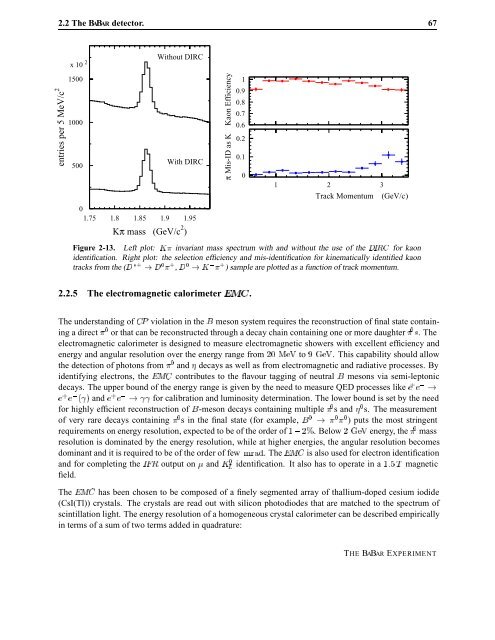Violation in Mixing
Violation in Mixing
Violation in Mixing
You also want an ePaper? Increase the reach of your titles
YUMPU automatically turns print PDFs into web optimized ePapers that Google loves.
2.2 The BABAR detector. 67<br />
entries per 5 MeV/c 2<br />
x 10 2<br />
1500<br />
1000<br />
500<br />
Without DIRC<br />
With DIRC<br />
0<br />
1.75 1.8 1.85 1.9 1.95<br />
Kπ mass (GeV/c 2 )<br />
Kaon Efficiency<br />
π Mis-ID as K<br />
1<br />
0.9<br />
0.8<br />
0.7<br />
0.6<br />
0.2<br />
0.1<br />
0<br />
1 2 3<br />
Track Momentum (GeV/c)<br />
Figure 2-13. Left plot: Ã� <strong>in</strong>variant mass spectrum with and without the use of the �ÁÊ� for kaon<br />
identification. Right plot: the selection efficiency and mis-identification for k<strong>in</strong>ematically identified kaon<br />
tracks from the (� £ � � � , � � Ã � ) sample are plotted as a function of track momentum.<br />
2.2.5 The electromagnetic calorimeter ��.<br />
The understand<strong>in</strong>g of �È violation <strong>in</strong> the � meson system requires the reconstruction of f<strong>in</strong>al state conta<strong>in</strong><strong>in</strong>g<br />
a direct � or that can be reconstructed through a decay cha<strong>in</strong> conta<strong>in</strong><strong>in</strong>g one or more daughter � ×. The<br />
electromagnetic calorimeter is designed to measure electromagnetic showers with excellent efficiency and<br />
energy and angular resolution over the energy range from Å�Î to ���Î. This capability should allow<br />
the detection of photons from � and � decays as well as from electromagnetic and radiative processes. By<br />
identify<strong>in</strong>g electrons, the �� contributes to the flavour tagg<strong>in</strong>g of neutral � mesons via semi-leptonic<br />
decays. The upper bound of the energy range is given by the need to measure QED processes like � � �<br />
� � and � � � for calibration and lum<strong>in</strong>osity determ<strong>in</strong>ation. The lower bound is set by the need<br />
for highly efficient reconstruction of �-meson decays conta<strong>in</strong><strong>in</strong>g multiple � s and � s. The measurement<br />
of very rare decays conta<strong>in</strong><strong>in</strong>g � s <strong>in</strong> the f<strong>in</strong>al state (for example, � � � � ) puts the most str<strong>in</strong>gent<br />
requirements on energy resolution, expected to be of the order of . Below ��Îenergy, the � mass<br />
resolution is dom<strong>in</strong>ated by the energy resolution, while at higher energies, the angular resolution becomes<br />
dom<strong>in</strong>ant and it is required to be of the order of few ÑÖ��. The �Å� is also used for electron identification<br />
and for complet<strong>in</strong>g the Á�Ê output on � and Ã Ä identification. It also has to operate <strong>in</strong> a �� Ì magnetic<br />
field.<br />
The �� has been chosen to be composed of a f<strong>in</strong>ely segmented array of thallium-doped cesium iodide<br />
(CsI(Tl)) crystals. The crystals are read out with silicon photodiodes that are matched to the spectrum of<br />
sc<strong>in</strong>tillation light. The energy resolution of a homogeneous crystal calorimeter can be described empirically<br />
<strong>in</strong> terms of a sum of two terms added <strong>in</strong> quadrature:<br />
THE BABAR EXPERIMENT















